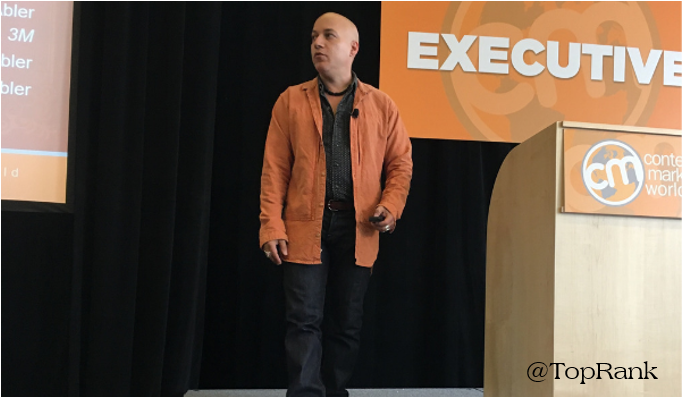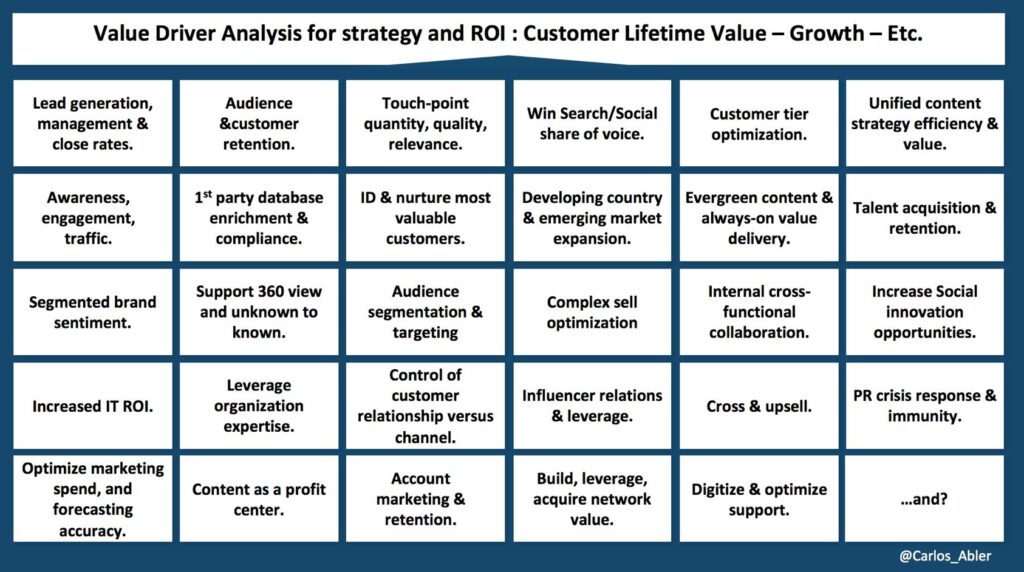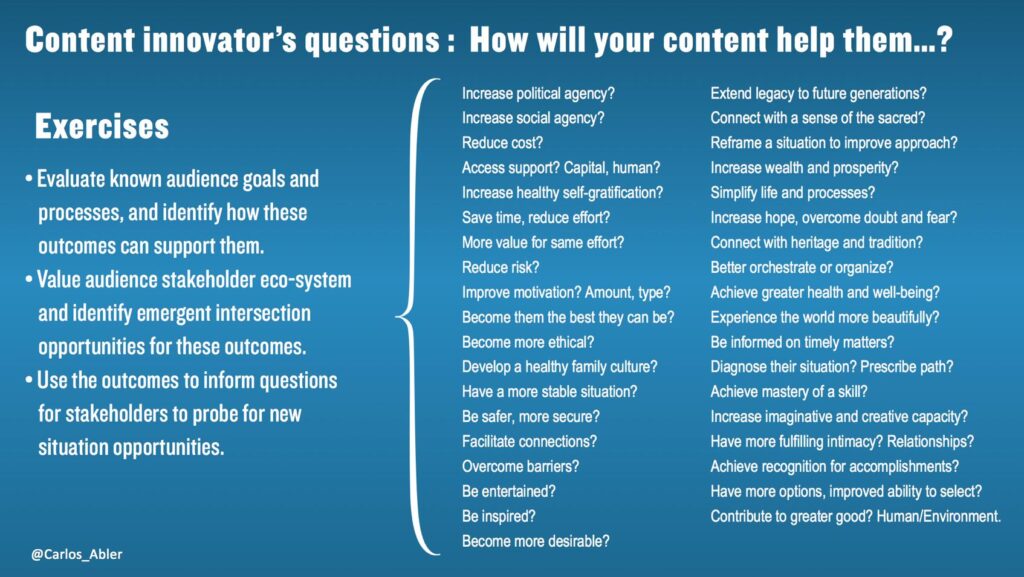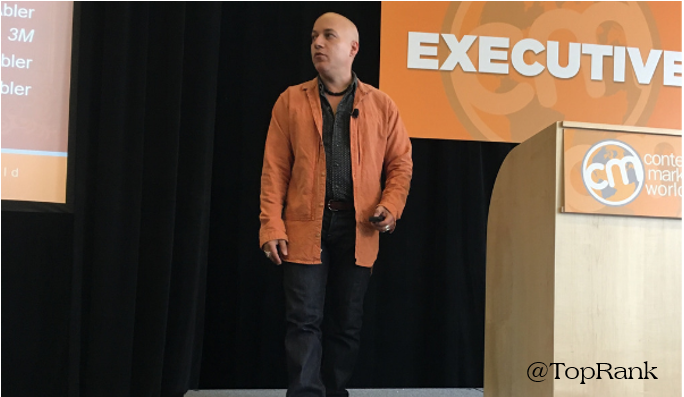
Can content marketing make the world a better place?
Let’s dial that in tighter: Can brands, businesses, make the world a better place?
And can they do it while making money at the same time?
According to content marketing leader Carlos Abler, not only can brands provide social value, they must – and, not for nothing, it’s in their best business interest to do so.
In his session at Content Marketing World 2019, Carlos shared a blueprint brands can follow to find the convergence of business value and social value.
How Can We Make Content More Valuable to Customers?
Stop me if you’ve heard this one: Content needs to be customer-centric, it needs to have value, and it needs to be relevant to the customer’s needs. Most content marketers could recite a similar mantra in their sleep. So if we all know better, why does content consistently miss the mark?
Carlos identified three reasons that we fall into the “value generation black hole”:
- Brand Egocentricity: It’s hard for brands to talk about anything but themselves.
- Product Silos: We tend to see people as vehicles to purchase our products, discounting the majority of their lived experience.
- Inward-Focused Organizations: It’s easy to lose sight of the customer’s experience in our day-to-day grind.
To turn that black hole into a big bang, says Carlos, we need to think about the different kinds of value we can bring to the customer:
- Product Value: We can help the customer understand how our product is valuable to them, and provide that value in the product. This is the easiest value for brands to express, but has the narrowest usefulness to the customer.
- Application Consulting Value: Helping our customer use our product most effectively or efficiently. Again, this is easy for brands to provide, but only of use to existing customers, or those very near the bottom of the funnel.
- Application Adjacency Value: Brands can help people do their job better as it involves the product, helping roll out the product throughout the organization. This broadens the scope of value beyond immediate customers, but is still pretty brand-centered.
- Non-Application Adjacent Value: Brands can help people be more successful in their careers, in ways that include but aren’t limited to the brand’s product or service. That’s the most valuable for the most people, and it’s the least about the brand.
To get started, Carlos says, start thinking about the pain points that don’t necessarily map to your product. For example, imagine you sell dental hygiene products for dentists’ offices. Most dentists have solo practices. Their pain points might include:
- How can I get more customers?
- How can I balance my books?
- How can I hire the right receptionist?
These problems are the most relevant to the dentist. But they have little to do with your product offering. The solution is to move away from the product to begin with, meet the dentist’s needs, and build a relationship from there.
But we can broaden the scope even further, Carlos argues.
How Can We Make Content More Valuable to Society?
We tend to think of value in content as a two-way street: We provide value to customers, and we get value for the business in return. But can our content change the world, too? Can we add social value to content?
Carlos believes we can. More importantly, he has plenty of real-world examples to back it up. Content can address enormous issues like poverty, hunger, sustainability… it can contribute to the greater good while still serving a business purpose.
To get started, Carlos suggests looking at the ways content can drive business value:

And searching for overlap with ways content can drive social value:

But here’s the real kicker: Economic and social issues are interconnected. They’re not two different types of problem, and we can’t keep thinking of them in silos.
Carlos quotes Edward R. Freeman: “We need to understand the complex interconnections between economic and social forces… Processes, techniques and theories that do not consider all of these forces will fail to describe and predict the business world as it really is.”
Making the Case for Social Entrepreneurship
The idea of using content to make the world a better place is a concept Carlos calls “Social Entrepreneurship.” He’s seen it work with small organizations, NGOs, groups who are trying to build a business case to solve a social problem.
What would happen, he asks, if we applied a business’ ability to scale with the social entrepreneur’s ability to identify social problems and find solutions?
One example Carlos provided is Aponjon, an SMS-text-based service for pregnant women and new mothers in Bangladesh. The program was developed to curb infant mortality rates, designed to be accessible and affordable. But rather than an externally-funded charity project, it’s a sustainable business. Paying for the service is optional, so the extremely poor can use it for free, but 80% of users choose to pay.
In the first 18 months, Aponjon gained 600,000 subscribers and achieved their goal of being a self-sustaining business.
Now imagine, Carlos says, that Aponjon was able to partner with a healthcare brand that could ethically use the platform as an opt-in database. There would be actual synergy (not the buzzword kind) between the business’ goals and the platform’s mission.
Consumers Want Brands to Provide Social Value—But Don’t Believe They Will
To wrap it up: When it comes to social value, customers have high expectations and low trust. The research Carlos presented boils down to, “We want brands to do good. But we don’t believe brands will do good. And we won’t trust them when they say they’re doing good. But we still want them to do it.”
The solution, Carlos says, is to make social value part of the company’s DNA. It can’t be surface-level. People can smell when brands are being shallow or exploitative, and they’ll back away. The only way to be authentic about it is to find that synergy between business value and social value, understand how the two are connected, and work towards providing both.
Need more Content Marketing World in your life? Stay tuned to the TopRank Marketing Blog for more tips, tricks, and live coverage. And follow our team: @leeodden, @NiteWrites, @azeckman, and @toprank on Twitter for real-time insights.



